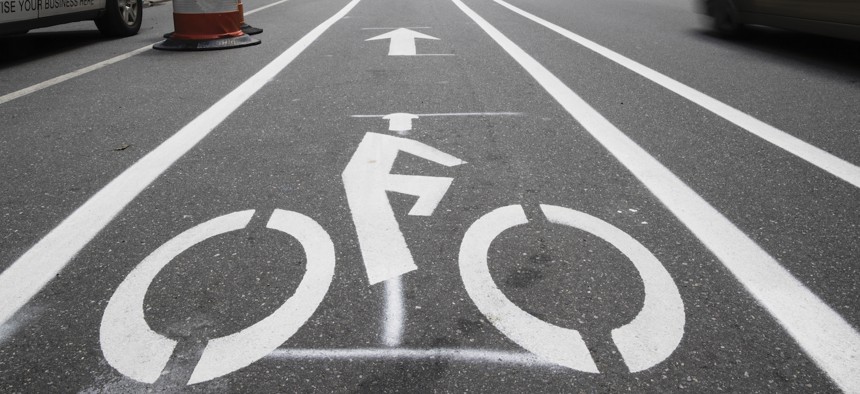For Pedestrian and Biking Projects, Some Progress in Latest Highway Bill

Shown is a recently created bicycle lane along Market Street in Philadelphia, Monday, June 4, 2018. AP Photo/Matt Rourke

Connecting state and local government leaders
But despite a hike in funding, advocates say the numbers are still paltry compared to the amount allocated for roads, bridges and highways.
Pedestrian and bicycling infrastructure would get a big boost in the Senate’s latest transportation funding plan, increasing by 40 percent to $1.2 billion per year.
While the increase is a welcome change for biking and pedestrian advocates, some say it still falls short of the overarching policy changes needed to truly invest in alternative transportation options.
“This bill largely reinforces the status quo—investing the lion’s share of funds based on formulas that keep active transportation on the margins despite growing public demand for safe, walkable, bikeable places,” said Kevin Mills, the vice president of policy at the Rails-to-Trails Conservancy. “Dedicated funding for walking and bicycling infrastructure continues to comprise only about 2% of the surface transportation budget with little policy direction to focus those investments on filling critical infrastructure gaps.”
Census data shows the number of American workers who commute to work by bicycle increased by about 60% from 2000 to 2012.
As walking and biking have gained popularity, bicycle and pedestrian deaths have also increased, underscoring the need for safer bike paths and walkways, advocates said.
The Fixing America's Surface Transportation (FAST) Act, which authorized $305 billion in spending on highways, bridges and other transportation infrastructure, is set to expire in 2020. The Senate Environment and Public Works Committee this week advanced the America’s Transportation Infrastructure Act of 2019—would reauthorize funding to improve and maintain surface transportation infrastructure across the United States.
It is still unclear is how lawmakers intend to pay for the legislation.
Much of the money appropriated through the bill—$259 billion—would be allocated to the states through formula grants that automatically apportion funding.
While the increase in set-aside funding that can only be used for pedestrian and cycling initiatives grew from amounts authorized in the FAST Act, the formulas used to distribute the bulk of the money to states is still based on car-centric factors such as increased speed and reduced congestion, said Scott Goldstein, policy director for Transportation For America.
“We don’t measure whether a road gets you to jobs and services, what the impact is on vehicle miles traveled, on greenhouse gas emissions,” Goldstein said. “That should be the priority of our transportation system. But basically what we have is that if you are going quickly in your car, you are having a good trip.”
Despite the criticism, others emphasized that the bill is a step in the right direction.
Caron Whitaker, vice president of government relations for the League of American Bicyclists, said it was good to see lawmakers include additional money that can only be used for improved cyclist and pedestrian safety.
States spent roughly $60 million on biking and walking safety improvements between 2014 and 2016, Whitaker said. But this bill could add another $500 to 750 million toward that effort over five years, including grants that incentivize states and urban areas to reduce their bicycle and pedestrian death and accident rates.
“For states and metropolitan areas that have a high rate of biking and walking fatalities, they have to spend the money on improvements for that,” Whitaker said.
Another policy change included in the legislation would provide more local control over walking and biking projects, ensuring they don’t get caught up in red tape, she said. Both states and Metropolitan Planning Organizations can receive federal funding for transportation infrastructure projects. But while MPOs could award and choose the projects they wanted to fund in the regions, they had to wait for the state to sign project contracts. The bill will give large MPOs the ability to move forward with their own priorities more quickly, Whitaker said.
Despite the increased funding for walking and biking infrastructure, the legislation does not bring funding for those initiatives above levels its reached in the recent past, Mills said.
“Restoring the cuts we made seven years ago is great, but it is not meeting this transformational opportunity,” Mills said.
Andrea Noble is a staff correspondent for Route Fifty.

NEXT STORY: A Pickup Truck State Debates California’s Electric Vehicle Rule




